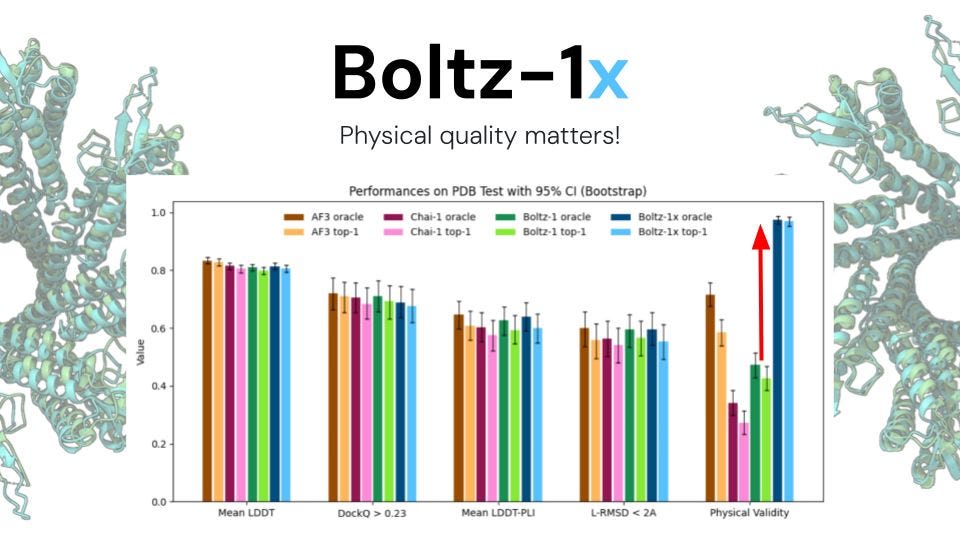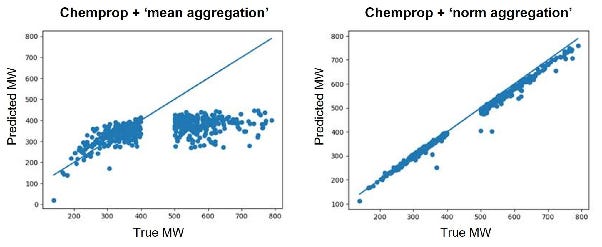deepmirror update | June 2025
New molecule-generation upgrades, AI at the FDA, extrapolating GNNs, Boltz-1x, and our Summer meet-ups
Welcome to the first edition of our new monthly update! Each month we’ll bring you the latest improvements to deepmirror, share noteworthy news, and flag upcoming events where you can meet the team.
This month we’re highlighting three product upgrades that make molecule generation more robust, smarter, and stereo-savvy. Meanwhile, the FDA has unveiled its Elsa AI platform, Merck researchers show that GNNs can extrapolate certain properties, and Boltz-1x boosts the physical realism of 3D poses. Finally, we share the Summer conferences where you can catch up with us.
Let’s dive in!
Product Updates
Generate Molecules in Challenging Projects
If the generator cannot find molecules that meet all of your goals, you can now interactively relax specific criteria on the fly. This guarantees you still receive a some design ideas instead of an empty result.
Support for Multiple Structure Filters
You may now apply multiple inclusion and exclusion filters simultaneously, giving you finer control over the chemical structures that appear in the generated molecules.
Stereochemistry-aware Molecule Generation
When your dataset contains stereoisomers, the generator automatically leverages that information to propose stereochemistry-aware structures.
News
FDA Launches Agency-Wide AI Tool
The FDA launched Elsa, a generative AI platform with advanced text-analysis and code-generation capabilities. Early applications include clinical-protocol review, and inspection-target prioritisation. Importantly, the models behind Elsa are not trained on on any proprietary data submitted to the agency.
Why it Matters
Elsa is the clearest sign yet that the FDA is investing heavily in AI, with more tools likely to follow. A faster, AI-assisted review process could shorten IND (Investigational New Drug) timelines, but it will also nudge applicants toward submitting data and reports in formats that are readily machine-readable.
GNN’s Can Extrapolate for Some Properties, But There’s a Trick
We love Pat Walter’s Practical Cheminformatics blog, and the latest guest post follows up on Why Don’t Machine Learning Models Extrapolate?, which examined why neural networks struggle to predict values outside their training range. In the new post, Alan Cheng and Jeffery Zhou (Merck) show that Chemprop graph-neural-network models do extrapolate to molecules outside the training set for additive endpoints such as molecular weight, but only after switching the read-out layer from the default mean aggregation to norm aggregation, which preserves atom-count information.
Why it Matters
This is a practical reminder that AI limitations often arise from both data and model architecture. Tweaking key hyper-parameters (here, the aggregation function) can unlock reliable out-of-distribution predictions and reduce the amount of new data required. If you’re using deepmirror, you’re in safe hands: automated hyper-parameter optimisation is performed for every model we build.
Boltz-1x — Major Update to the Boltz-1 Model

Boltz-1x, a significant update to the open-source Boltz-1 biomolecular-interaction model, addresses shortcomings of earlier 3D structure prediction models, such as distorted geometries, incorrect chirality, and steric clashes. It introduces inference-time steering: during diffusion, particle positions are nudged with gradient steps and periodically resampled under a force-field-inspired potential. The result is higher physical fidelity and more reliable binding poses.
Why it Matters
By driving predictions toward physically realistic conformations, Boltz-1x closes a gap left by models such as AlphaFold-3, Chai-1 and its own predecessor. More trustworthy 3D poses give us stronger starting points for hypothesis generation, especially when rationalising protein-ligand interactions, while reducing the need for manual clean-up or downstream energy minimisation.
Where to Meet Us
Let us know if you’ll be at any of these events and we’ll find time to connect:
11th | Cambridge (UK) — Cambridge Wide Open Week
12th June | Cambridge (UK) — TechBio x Cambridge Networking Event
13th June | London (UK) — Research and Applied AI Summit
30 June | Cambridge (UK) — Milner Therapeutics Symposium
2nd — 4th July | Orléans (France) — RICT 2025



